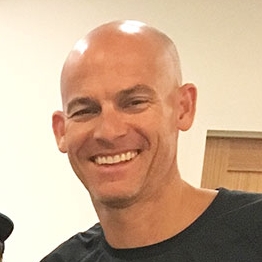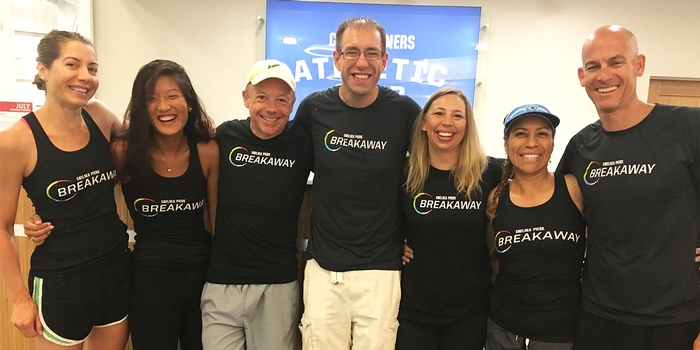Race Report: Ironman Lake Placid 2017
![]()
July 28, 2017
Mitch West
This year’s Ironman Lake Placid was my fourteenth Ironman overall and my seventh in Placid. My first was in 2009, and I have since raced there in 2010, 2012, 2013, 2014, and 2015. I love Lake Placid and really enjoy this race. I’ve also had some pretty good success there, qualifying for the Ironman World Championships in Kona, Hawaii in five of those six previous races, but I have never won my age group. A couple of second place finishes, a third, but never a “W.” Leading up to this year’s race, I had two pretty solid races up at Lake Quassy at the Rev3 Half Ironman and the Pat Griskus Olympic Triathlon. A full Ironman, however, is a different beast, and you never really know how it’s going to go, no matter your fitness.
 Mitch on the running leg of Ironman Lake Placid.
Mitch on the running leg of Ironman Lake Placid.Thankfully, my swim was uneventful. The goal is to not get kicked in the face. For almost everyone in an Ironman, the swim is about 10% of their race (i.e. a ten-hour race, a one-hour swim). I swim 58 minutes at pretty much every Ironman race with a wetsuit. My goal is to swim smart, not necessarily hard: Find some feet going my speed and settle in behind them for the draft, which is a real benefit. I stayed quite comfortable for both loops and managed to stay out of trouble.
 Mitch on the running leg of Ironman Lake Placid.
Mitch on the running leg of Ironman Lake Placid.Once on the bike, the course is a flat road for just a few miles before the climb to the top of the descent to Keene begins. I don’t use a power meter, so I race by heart rate and try to let it settle down from the swim. The weather this year was nice and cool, and there was even a little rain at the bottom of the five-mile descent. Conditions like these are ideal to go fast as you can keep your core temperature down and put out decent power without blowing up. I went through the first loop of the bike in roughly 2:33, probably the fastest loop I’ve ever ridden there. That definitely scared me, because that is awfully quick for me and I feared that the second loop would be a full hour slower, but my heart rate was low and I was feeling good and staying on top of my nutrition and salt. I’ll admit the conditions were fast also—my second loop was roughly 2:43 for an overall bike split of 5:15:59 (21.27 mph), my fastest ever at this race.
 Mitch on the podium receiving his award for winning the Men’s 45-49 age group.
Mitch on the podium receiving his award for winning the Men’s 45-49 age group.My parents are pretty amazing people, and they have come to all seven of my races up there (they drive from Michigan)! My dad was yelling to me after the first loop of the bike that I was leading my age group (Men’s 45-49). As I exited the second transition and started on the run, he yelled again that I was “in the lead.” I felt good to start the run, and my focus was on continuing to fuel, get salt, and to take it nice and easy. I don’t use heart rate on the run, as I know what my pace needs to be, so I work off that instead. Essentially, if I can’t speak in full sentences, I am going too hard. I don’t know what my split was at the halfway point, but it was clear I was slowing on the second loop. Everyone slows down in the back half of the marathon, but the goal is to be the one who slows down the least. I’m quite sure I was NOT that guy! My calves really started to hurt, and it felt like I was barely moving. I saw second place (a guy I know and have raced before) at the turnarounds and figured he was about five to six minutes back. There were so many people I know out there yelling and cheering. That kind of support from the crowd is invaluable. Once back in town, it’s only a couple of miles to push hard. I ended up with a 3:28:08 marathon—not my best, but certainly not my worst. My total time was 9:51:35, good enough for my first Ironman Age Group victory. I was only four minutes off of my 9:47 Ironman Lake Placid PR, which I set in 2013.
 Mitch (R) with fellow triathletes (from L to R) Caitlin Drap, Kim Jerome, Peter Bang, James Strol, Emily Walgenbach and Claudia Smith before the race.
Mitch (R) with fellow triathletes (from L to R) Caitlin Drap, Kim Jerome, Peter Bang, James Strol, Emily Walgenbach and Claudia Smith before the race.So, why do you care about any of this? Well, you probably don’t, but if you’ve read this far, I’ll give you a takeaway. As some of you may know, I began coaching cycling at Chelsea Piers Connecticut in January of 2017, and the new IC7 bikes came into the cycling studio in March. I teach four or five Breakaway classes per week, and I am quite clear that these bikes have vastly improved my cycling ability. These are not “spin bikes.” They allow the rider to train with power (watts) and know precisely how hard he or she is working as a percentage of their FTP (Functional Threshold of Power). I have pushed myself (and hopefully you too) harder in these classes than I ever have in the past. At age 47, I was quite surprised to set a PR on the bike. Folks don’t generally get stronger as they head to their late forties. More than that, I was able to do it while maintaining a relatively low effort that allowed me to put out a decent run. But what if your goal is not to train for an Ironman on the IC7? What if you just want a good workout? What if you want to burn calories? What if you want to get stronger? Check, check and check. Training in distinct power zones allows you to know exactly how hard you are working, and how much you are pushing yourself. Gone are the days of spinning your legs fast with no clue of whether or not you are actually producing any power. I look forward to seeing you in class soon!

